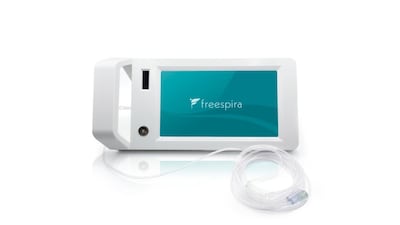Axena Health CEO Eileen Maus keeps a sign in her office that reads “Sisu [noun] [Finnish]: The extraordinary and indomitable Finnish spirit to never quit and go beyond all limitations, especially in the face of extreme adversity.”
The 25-year femtech vet isn’t herself Finnish; instead, she said, the sign describes the qualities she feels are important in bringing innovative women’s health products to market. To her, it’s a reminder that “if we don't advocate for ourselves, it won't get done.”

And that spirit has helped to animate the work of Axena. The company’s sole product is the Leva pelvic system, which treats incontinence by helping to strengthen the pelvic floor. Typically, women experiencing incontinence are told to strengthen the area through “Kegels,” or pelvic floor muscle training (PFMT). But many people struggle to do the exercises correctly or consistently on their own, Maus told Medtech Insight.
The Leva system consists of an app that connects to an inserted vaginal motion sensor. Women wear the device while doing PFMT exercises for five minutes each day, and Leva tracks the consistency and accuracy of their efforts. The software also offers education on pelvic floor exercise and allows users to visualize pelvic movement in real time.
The US Food and Drug Administration cleared the Leva system to treat most forms of urinary incontinence in 2019 and added an indication to treat fecal incontinence in 2023 under a breakthrough device designation. The dual designation means that the 20% of women who have both urinary and fecal incontinence can use Leva to treat both, Axena says.
The company’s most recent milestone has been a new code under the Healthcare Common Procedure Coding System (HCPCS). Axeta began to pursue a HCPCS code in November 2023, after insurers approached the company about the difficulty of billing for Leva without a specific code. The new code will become effective on 1 April.
Misconceptions May Delay Treatment
Incontinence is surprisingly common, with one study finding that about 60% of US women had at least some symptoms. But, Maus said, many people with the condition fail to pursue medical treatment, either due to embarrassment or because they are not aware of their options.
“The biggest lie our grandmother ever told us is that leaking is a normal part of aging,” she said. “It is not normal. It's super common, but it is not normal.”
That lack of knowledge can have far-reaching consequences, Maus said. For example, incontinence is the second most common reason women are admitted to nursing homes.
“If that was diabetes, or cardiac problems, or something else that was the number two reason why women were admitted into nursing homes, I think there will be a national outrage,” she said. “But when we talk about our anatomy that's uniquely female, all of a sudden, everybody freaks out.”
‘Great Clinical Evidence’ Eases Path To Use
Maus’s general advice to medtech executives is to prioritize generating data that strongly supports the use of their product. Everything else, she said, can go to the backburner.
“Patients deserve [strong data], and insurers and clinicians demand it,” she said. “So make sure your data is tight. That's where you're going to invest your money. Marketing can wait until you make sure you have good clinical data.”
In the case of Leva, clinical evidence has helped Axena to promote the device both to physicians and to insurers. A pivotal trial found that eight weeks of daily exercise with Leva reduces leaking episodes from about twice per day to twice per week. Patient scores on the Urinary Distress Inventory-6 scale dropped from 52.9 to 36.3; a score of 37 or below means that the patient’s symptoms likely no longer reduce their quality of life.
Additionally, a study published earlier this year found that patients who used Leva for 12 weeks are still experiencing benefits two years later. Maus says the treatment is also both minimally invasive and more cost-effective than overactive bladder medications, which may cost hundreds of dollars a month and typically must be taken for life.
Physicians are also attracted by the ease with which Leva allows them to track a patient’s progress. That’s a major advantage over the past practice of referring out for physical therapy, in which patients are often lost to follow up, she added.
And that physician buy-in is crucial, Maus said.
“At the end of the day, women are diagnosed with urinary incontinence when the clinician asks them that question,” she explained. “So the way to get the treatment to women is to have their physician recommend it to them.”
Women’s Health Has ‘Gotten More Challenging’
Developing devices to treat women’s health conditions has not gotten easier since Maus entered the field in the 1990s, she said.
“I think back all the time and ask myself, was it harder 25 years ago?” she said. “I don’t think it was. I think it’s gotten more challenging.”
The reasons behind this, Maus says, are varied. First, she finds that women remain reluctant to put themselves first and demand appropriate care. Additionally, treatments have historically not been developed with female anatomy or female hormones in mind. Conditions ranging from autoimmune disease to heart attacks may present differently in women than in men.
Additionally, the medical establishment has sometimes been reluctant to treat female-specific concerns seriously. As an example, Maus cites her experience decades ago at a diagnostics firm called Cytyc Health Corp., which has since been purchased by Hologic, Inc.. The company made a widely used cervical cancer test called the ThinPrep Pap Smear. Unfortunately, at the time labs treated Pap smears as “loss leaders,” which were reimbursed at such a low level that the labs lost money performing them.
“Of course, that wasn’t survivable as a business,” she said. “So we had a three-to-five year fight to get appropriate reimbursement for the test. And it was the same time that [Viagra] came out.” And the erectile dysfunction drug, she said, faced none of the reimbursement challenges Cytyc had been experiencing.
“I was young at that time, and I thought ‘Wait a minute, we're putting all this money to men's erections, but something that can kill women is a loss leader,’” she recounts. “It was a little bit like, ‘My, that's interesting.’”




